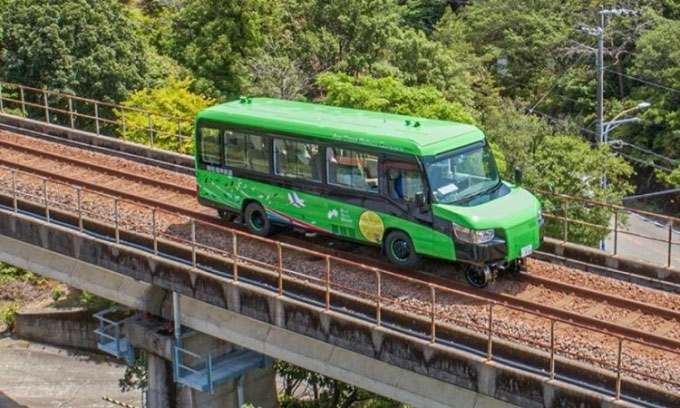Trains that run on railways in Japan start operating
The new Dual Bus (DMV) will start operating in Japan on December 25, and can run at 80 km/h in rail mode.
Developed since 2002, the DMV system is operated by Japan's Asa Coastal Railway Company. The system, which now integrates three vehicles, can run for about 123 kilometers from the Awa Kainan Bunka Mura cultural facility in Tokushima prefecture to the Umi no Eki Toromu marina in Kochi prefecture.

DMV buses can switch between rail and road modes within 15 seconds.
Each DMV is a modified diesel bus that can carry 23 passengers with a driver. On the road, the vehicle uses tires just like any other bus. When running along the dedicated track, the driver only needs to push a button to let the rail wheels protrude from under the vehicle at the front and rear.
The vehicle's front wheels are raised above the track while the rear wheels are still in contact with the rails to provide thrust. The vehicle has a maximum speed of 80 km/h in railway mode and a cruise speed of 60 km/h. Along the coastal route, the DMV will change modes twice. The whole process of changing modes takes only 15 seconds. For safety reasons, the vehicle does not run on the existing tracks used by the trains.
According to Asa, the DMV's ability to run most of the route on rails will make the vehicle more fuel efficient and less polluting than conventional buses. The vehicle is also low maintenance and can transport people in the event of an earthquake or other disaster, on both highways and rails.
The DMV will become the world's first dual-mode bus to enter service. However, railway maintenance trucks have been using the same technology for decades.
- The whole of the Dutch tram runs on wind power
- Japan tests super-speed train running on the magnetic buffer
- Half a century the world has high-speed trains
- Battery trains can travel 1000km
- Speed can reach 500 km / h or higher
- What if we combine trains with airplanes?
- India trains run by solar energy
- High-speed trains close to the ground
- Transparent rail on suspension
- Why do I have to spread rails?
- China launched the world's fastest railway
- Spring of electric trains
 The US company is about to build a supersonic passenger plane of 6,000km / h
The US company is about to build a supersonic passenger plane of 6,000km / h Japan develops avatar robot as in fiction film
Japan develops avatar robot as in fiction film Australia tested the world's first mango picking robot
Australia tested the world's first mango picking robot America develops technology to separate water from animal waste
America develops technology to separate water from animal waste